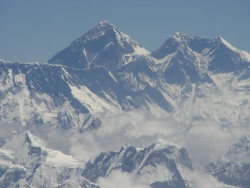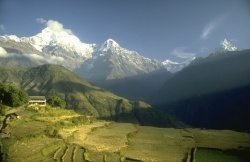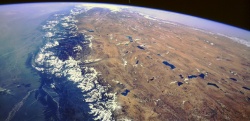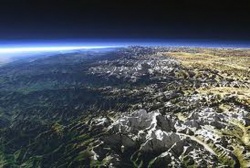Himalayas
The Himalayas, also Himalaya, (pron.: /ˌhɪməˈleɪ.ə/ or /hɪˈmɑːləjə/; Sanskrit, hima (snow) + ālaya (dwelling), literally, "abode of the snow" ) is a mountain range in Asia separating the plains of the Indian subcontinent from the Tibetan Plateau.
The Himalayan range is home to some of the planet's highest peaks, including the highest, Mount Everest. The Himalayas include over a hundred mountains exceeding 7,200 metres (23,600 ft) in height. By contrast, the highest peak outside Asia—Aconcagua, in the Andes— is 6,961 metres (22,838 ft) tall. The Himalayas have profoundly shaped the cultures of South Asia. Many Himalayan peaks are sacred in both Hinduism and Buddhism.
Besides the Greater Himalayas of these high peaks there are parallel lower ranges. The first foothills, reaching about a thousand meters along the northern edge of the plains, are called the Sivalik Hills or Sub-Himalayan Range. Further north is a higher range reaching two to three thousand meters known as the Lower Himalayan or Mahabharat Range.
The Himalayas abut or cross five countries: Bhutan, India, Nepal, China, and Pakistan, with the first three countries having sovereignty over most of the range. The Himalayas are bordered on the northwest by the Karakoram and Hindu Kush ranges, on the north by the Tibetan Plateau, and on the south by the Indo-Gangetic Plain.
Three of the world's major rivers, the Indus, the Ganges, and the Tsangpo-Brahmaputra all rise near Mount Kailash to cross and encircle the Himalayas. Their combined drainage basin is home to some 600 million people.
Lifted by the subduction of the Indian tectonic plate under the Eurasian Plate, the Himalayan range runs, west-northwest to east-southeast, in an arc 2,400 kilometres (1,500 mi) long. Its western anchor, Nanga Parbat, lies just south of the northernmost bend of Indus river, its eastern anchor, Namcha Barwa, just west of the great bend of the Tsangpo river. The range varies in width from 400 kilometres (250 mi) in the west to 150 kilometres (93 mi) in the east.
Ecology
Main article: Ecology of the Himalaya
The flora and fauna of the Himalayas vary with climate, rainfall, altitude, and soils. The climate ranges from tropical at the base of the mountains to permanent ice and snow at the highest elevations. Owing to the mountains’ latitude near the Tropic of Cancer, the permanent snow line is among the highest in the world at typically around 5,500 metres (18,000 ft). In contrast, equatorial mountains in New Guinea, the Rwenzoris and Colombia have a snow line some 900 metres (2,950 ft) lower. The amount of yearly rainfall increases from west to east along the southern front of the range. This diversity of altitude, rainfall and soil conditions combined with the very high snow line supports a variety of distinct plant and animal communities. For example the extremes of high altitude (low atmospheric pressure) combined with extreme cold allow extremophile organisms to survive.
The unique floral and faunal wealth of the Himalayas is undergoing structural and compositional changes due to climate change. The increase in temperature may shift various species to higher elevations. The oak forest is being invaded by pine forests in the Garhwal Himalayan region. There are reports of early flowering and fruiting in some tree species, especially rhododendron, apple and Myrica esculenta. The highest known tree species in the Himalayas is Juniperus tibetica located at 4,900 metres (16,080 ft) in Southeastern Tibet.
Geology
The 6,000 km plus journey of the India landmass (Indian Plate) before its collision with Asia (Eurasian Plate) about 40 to 50 million years ago
Main article: Geology of the Himalaya
The Himalayas are among the youngest mountain ranges on the planet and consist mostly of uplifted sedimentary and metamorphic rock. According to the modern theory of plate tectonics, their formation is a result of a continental collision or orogeny along the convergent boundary between the Indo-Australian Plate and the Eurasian Plate. This is referred to as a fold mountain.
The collision began in the Upper Cretaceous period about 70 million years ago, when the north-moving Indo-Australian Plate, moving at about 15 cm per year, collided with the Eurasian Plate. About 50 million years ago, this fast moving Indo-Australian plate had completely closed the Tethys Ocean, the existence of which has been determined by sedimentary rocks settled on the ocean floor, and the volcanoes that fringed its edges. Since these sediments were light, they crumpled into mountain ranges rather than sinking to the floor. The Indo-Australian plate continues to be driven horizontally below the Tibetan plateau, which forces the plateau to move upwards. The Arakan Yoma highlands in Myanmar and the Andaman and Nicobar Islands in the Bay of Bengal were also formed as a result of this collision.
The Indo-Australian plate is still moving at 67 mm per year, and over the next 10 million years it will travel about 1,500 km into Asia. About 20 mm per year of the India-Asia convergence is absorbed by thrusting along the Himalaya southern front. This leads to the Himalayas rising by about 5 mm per year, making them geologically active. The movement of the Indian plate into the Asian plate also makes this region seismically active, leading to earthquakes from time to time.
During the last ice age, there was a connected ice stream of glaciers between Kangchenjunga in the east and Nanga Parbat in the west. In the west, the glaciers joined with the ice stream network in the Karakoram, and in the north, joined with the former Tibetan inland ice. To the south, outflow glaciers came to an end below an elevation of 1,000–2,000 metres (3,300–6,600 ft). While the current valley glaciers of the Himalaya reach at most 20 to 32 kilometres (12 to 20 mi) in length, several of the main valley glaciers were 60 to 112 kilometres (37 to 70 mi) long during the ice age. The glacier snowline (the altitude where accumulation and ablation of a glacier are balanced) was about 1,400–1,660 metres (4,600–5,450 ft) lower than it is today. Thus, the climate was at least 7.0 to 8.3 °C (45 to 47 °F) colder than it is today.
Hydrology
Tista River
The Himalayan range at Yumesongdong in Sikkim, in the Yumthang River valley
The Himalayan range encompasses about 15,000 glaciers, which store about 12,000 km3 (3000 cubic miles) of fresh water. Its glaciers include the Gangotri and Yamunotri (Uttarakhand) and Khumbu glaciers (Mount Everest region), and Zemu (Sikkim).
The higher regions of the Himalayas are snowbound throughout the year, in spite of their proximity to the tropics, and they form the sources of several large perennial rivers, most of which combine into two large river systems:
The western rivers combine into the Indus Basin, of which the Indus River is the largest. The Indus begins in Tibet at the confluence of Sengge and Gar rivers and flows southwest through India and then through Pakistan to the Arabian Sea. It is fed by the Jhelum, the Chenab, the Ravi, the Beas, and the Sutlej rivers, among others.
Most of the other Himalayan rivers drain the Ganges-Brahmaputra Basin. Its main rivers are the Ganges, the Brahmaputra and the Yamuna, as well as other tributaries. The Brahmaputra originates as the Yarlung Tsangpo River in western Tibet, and flows east through Tibet and west through the plains of Assam. The Ganges and the Brahmaputra meet in Bangladesh, and drain into the Bay of Bengal through the world's largest river delta.
The easternmost Himalayan rivers feed the Ayeyarwady River, which originates in eastern Tibet and flows south through Myanmar to drain into the Andaman Sea.
The Salween, Mekong, Yangtze and Huang He (Yellow River) all originate from parts of the Tibetan plateau that are geologically distinct from the Himalaya mountains, and are therefore not considered true Himalayan rivers. Some geologists refer to all the rivers collectively as the circum-Himalayan rivers. In recent years, scientists have monitored a notable increase in the rate of glacier retreat across the region as a result of global climate change. For example, Glacial lakes have been forming rapidly on the surface of the debris-covered glaciers in the Bhutan Himalaya during the last few decades. Although the effect of this will not be known for many years, it potentially could mean disaster for the hundreds of millions of people who rely on the glaciers to feed the rivers of northern India during the dry seasons.
Lakes
A high Himalayan lake at an altitude of around 5,000 metres Sikkim, India
The Himalayan region is dotted with hundreds of lakes. Most lakes are found at altitudes of less than 5,000 m, with the size of the lakes diminishing with altitude. Pangong Tso, which is spread across the border between India and China, and Yamdrok Tso, located in central Tibet, are amongst the largest with surface areas of 700 km², and 638 km², respectively. Other notable lakes include Gurudogmar lake in North Sikkim, Tsongmo lake, near the Indo-China border in Sikkim, and Tilicho lake in Nepal in the Annapurna massif.
The mountain lakes are known to geographers as tarns if they are caused by glacial activity. Tarns are found mostly in the upper reaches of the Himalaya, above 5,500 metres.
Impact on climate
The Himalayas have a profound effect on the climate of the Indian subcontinent and the Tibetan plateau. They prevent frigid, dry Arctic winds blowing south into the subcontinent, which keeps South Asia much warmer than corresponding temperate regions in the other continents. It also forms a barrier for the monsoon winds, keeping them from traveling northwards, and causing heavy rainfall in the Terai region. The Himalayas are also believed to play an important part in the formation of Central Asian deserts, such as the Taklamakan and Gobi.
Religion
Pass in Ladakh with the typical Buddhist prayer flags and chorten
The Taktshang Monastery, also known as the "Tiger's Nest"
In Hinduism, the Himalaya have also been personified as the god Himavat, the God of snow, who is mentioned in the Mahabharata. He is father of Ganga and Saraswati, who became rivers, and Parvati, who married Shiva
Several places in the Himalaya are of religious significance in Hinduism, Jainism, Sikhism, Buddhism, and Islam. A notable example of a religious site is Paro Taktsang, where Padmasambhava is said to have founded Buddhism in Bhutan.
A number of Tibetan Buddhist sites are situated in the Himalaya, including the residence of the Dalai Lama. There were over 6,000 monasteries in Tibet. The Tibetan Muslims had their own mosques in Lhasa and Shigatse.



